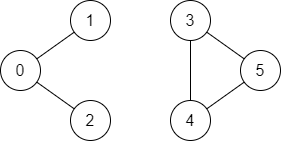原文链接: https://leetcode-cn.com/problems/find-if-path-exists-in-graph
英文原文
There is a bi-directional graph with n vertices, where each vertex is labeled from 0 to n - 1 (inclusive). The edges in the graph are represented as a 2D integer array edges, where each edges[i] = [ui, vi] denotes a bi-directional edge between vertex ui and vertex vi. Every vertex pair is connected by at most one edge, and no vertex has an edge to itself.
You want to determine if there is a valid path that exists from vertex start to vertex end.
Given edges and the integers n, start, and end, return true if there is a valid path from start to end, or false otherwise.
Example 1:

Input: n = 3, edges = [[0,1],[1,2],[2,0]], start = 0, end = 2 Output: true Explanation: There are two paths from vertex 0 to vertex 2: - 0 → 1 → 2 - 0 → 2
Example 2:

Input: n = 6, edges = [[0,1],[0,2],[3,5],[5,4],[4,3]], start = 0, end = 5 Output: false Explanation: There is no path from vertex 0 to vertex 5.
Constraints:
1 <= n <= 2 * 1050 <= edges.length <= 2 * 105edges[i].length == 20 <= ui, vi <= n - 1ui != vi0 <= start, end <= n - 1- There are no duplicate edges.
- There are no self edges.
中文题目
有一个具有 n个顶点的 双向 图,其中每个顶点标记从 0 到 n - 1(包含 0 和 n - 1)。图中的边用一个二维整数数组 edges 表示,其中 edges[i] = [ui, vi] 表示顶点 ui 和顶点 vi 之间的双向边。 每个顶点对由 最多一条 边连接,并且没有顶点存在与自身相连的边。
请你确定是否存在从顶点 start 开始,到顶点 end 结束的 有效路径 。
给你数组 edges 和整数 n、start和end,如果从 start 到 end 存在 有效路径 ,则返回 true,否则返回 false 。
示例 1:

输入:n = 3, edges = [[0,1],[1,2],[2,0]], start = 0, end = 2 输出:true 解释:存在由顶点 0 到顶点 2 的路径: - 0 → 1 → 2 - 0 → 2
示例 2:

输入:n = 6, edges = [[0,1],[0,2],[3,5],[5,4],[4,3]], start = 0, end = 5 输出:false 解释:不存在由顶点 0 到顶点 5 的路径.
提示:
1 <= n <= 2 * 1050 <= edges.length <= 2 * 105edges[i].length == 20 <= ui, vi <= n - 1ui != vi0 <= start, end <= n - 1- 不存在双向边
- 不存在指向顶点自身的边
通过代码
高赞题解
解题思路

没有思路,直接上。
朴素的深度优先
朴素地记录点到点的对应关系,然后使用 dfs 遍历,记住访问过的点防止死循环,毫无疑问超时了;
class Solution {
public:
bool validPath(int n, vector<vector<int>>& edges, int start, int end) {
vector<vector<int>> graph(n, vector<int>());
for(vector<int> edge : edges){
graph[edge[0]].emplace_back(edge[1]);
graph[edge[1]].emplace_back(edge[0]);
}
function<bool(int, vector<bool>)> getRes= [&](int index, vector<bool> isVisited){
for(int vertex : graph[index]){
if(!isVisited[vertex]){
if(vertex == end) return true;
isVisited[vertex] = true;
bool res = getRes(vertex, isVisited);
if(res == true) return true;
isVisited[vertex] = false;
}
}
return false;
};
return getRes(start, vector<bool>(n, false));
}
};优化的深度优先
我以为超时的原因是数据量太大数组插入元素耗时太多,所以使用二维矩阵记录图的路径,对图进行深度优先遍历,果然坚持了比前一个多的测试用例,但还是超时了。
class Solution {
public:
bool validPath(int n, vector<vector<int>>& edges, int start, int end) {
if(start == end) return true;
vector<vector<bool>> graph(n, vector<bool>(n, false));
for(vector<int> edge : edges){
graph[edge[0]][edge[1]] = graph[edge[1]][edge[0]] = true;
}
function<bool(int, vector<bool>)> getRes= [&](int index, vector<bool> isVisited){
for(int vertex = 0; vertex < n; vertex++){
if(!isVisited[vertex] && graph[index][vertex] == true){
if(end == vertex) return true;
isVisited[vertex] = true;
bool res = getRes(vertex, isVisited);
if(res == true) return true;
isVisited[vertex] = false;
}
}
return false;
};
return getRes(start, vector<bool>(n, false));
}
};寻找连通分支的点集
我太菜了,忘记图怎么找到连通分支了,所以就很常规地寻找每个点能到达的点的集合,加入一个新顶点时,要把集合中所有点和这个顶点相连,最后判断起始点和终止点是否在一个可到达的点集中;
还是那个问题,超时了,循环太多,最坏的情况是每个点都连通,每次都要循环遍历点集。
class Solution {
public:
bool validPath(int n, vector<vector<int>>& edges, int start, int end) {
if(start == end) return true;
vector<set<int>> graph(n, set<int>());
for(vector<int> edge : edges){
for(int vertex : graph[edge[0]]){
graph[vertex].insert(edge[1]);
graph[edge[1]].insert(vertex);
}
for(int vertex : graph[edge[1]]){
graph[vertex].insert(edge[0]);
graph[edge[0]].insert(vertex);
}
graph[edge[0]].insert(edge[1]);
graph[edge[1]].insert(edge[0]);
}
for(int vertex : graph[start]){
if(vertex == end) return true;
}
return false;
}
};优化找点集
为了避免每次都要遍历点集,我把每个连通分支标号,每个连通分支的顶点映射到各自连通分支的标号;
有点 Dijkstra 那味道,遍历到每条边时,分为三种情况:
1、两个端点都没有归并到一个连通分支中,将两个顶点归并到同一个连通分支,标号记为 sign,然后标记加1,用于下一个新连通分支的标记
2、有一个端点被记录过,另一各端点没有,则将未记录过的端点合并到已记录过端点的连通分支中,即为其赋值为连通分支标号
3、两个端点都被记录过,如果记录的值是同一个连通分支,则跳过;否则,总是以标号较大的那个连通分支作为合并后的连通分支标号(边是随机的,用哪个都行)
使用两个映射结构,vts表示每个顶点映射到的连通分支号,stv表示该连通分支内所有的顶点,每次在需要时更新这两个数据结构;最后,比较起始点和终止点是否在同一个连通分支内即可;可能交的人比较少,达到了双百。
class Solution {
public:
bool validPath(int n, vector<vector<int>>& edges, int start, int end) {
unordered_map<int, int> vts; //每个顶点映射到的连通分支号
unordered_map<int, vector<int>> stv; //该连通分支内所有的顶点
int sign = 1; //连通分支号
for(vector<int> edge : edges){
if(vts[edge[0]] > 0 && vts[edge[1]] > 0){ //两个端点都被记录过
if(vts[edge[0]] == vts[edge[1]]) continue; //在同一个连通分支
if(vts[edge[0]] > vts[edge[1]]){
for(int vertex : stv[vts[edge[1]]]){
stv[vts[edge[0]]].emplace_back(vertex);
vts[vertex] = vts[edge[0]];
}
}
else{
for(int vertex : stv[vts[edge[0]]]){
stv[vts[edge[1]]].emplace_back(vertex);
vts[vertex] = vts[edge[1]];
}
}
}
else if(vts[edge[0]] > 0){ //有一个端点被记录过,另一各端点没有
vts[edge[1]] = vts[edge[0]];
stv[vts[edge[0]]].emplace_back(edge[1]);
}
else if(vts[edge[1]] > 0){ //有一个端点被记录过,另一各端点没有
vts[edge[0]] = vts[edge[1]];
stv[vts[edge[1]]].emplace_back(edge[0]);
}
else{ //两个端点都没有归并到一个连通分支中
vts[edge[0]] = vts[edge[1]] = sign;
stv[sign].emplace_back(edge[0]);
stv[sign].emplace_back(edge[1]);
sign += 1;
}
}
// for(int i = 0; i < n; i++){
// cout<<vts[i]<<" ";
// }
return vts[start] == vts[end];
}
};(:该去学习大佬们的算法了
统计信息
| 通过次数 | 提交次数 | AC比率 |
|---|---|---|
| 908 | 1677 | 54.1% |
提交历史
| 提交时间 | 提交结果 | 执行时间 | 内存消耗 | 语言 |
|---|




